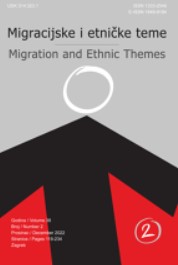Pregled nezakonitih ulazaka u EU na području Sredozemlja od 2016. do 2021. godine
Overview of Illegal Entries into the EU in the Mediterranean Area from 2016 to 2021
Author(s): Antonio VulasSubject(s): Comparative politics, Present Times (2010 - today), Migration Studies, Ethnic Minorities Studies, Asylum, Refugees, Migration as Policy-fields
Published by: Institut za migracije i narodnosti
Keywords: migration; Mediterranean; Western-Balkan route; migration routes;
Summary/Abstract: The article provides an overview of the number of illegal entries into the Member States of the European Union in the Mediterranean area. At the same time, separate reviews are presented for each of the three areas – the Eastern Mediterranean, the Central Mediterranean and the Western Mediterranean. The review period is limited by the last phase of the “migration crisis” of 2015/2016 and the COVID-19 pandemic, which also affected the number of illegal entries of third-country nationals into the EU. The paper presents exclusively statistical data relating to the external borders of Spain, Italy, Greece and Bulgaria. These four countries are the most represented in terms of the number of illegal entries of migrants through the southern borders of the EU. Other countries on the southern borders of the EU - Portugal, France, Croatia, Malta and Cyprus - have an insignificant share in the number of illegal entries of migrants or do not record such entries at all via sea borders. By presenting the trends in the number of illegal entries into the EU by the third-country nationals over a longer period, an attempt is made to give an insight into the possible influences that lead to stagnation or the progression of the analysed numbers in relation to possible factors of influence. The sources of data are the statistics of international organisations in charge of dealing with migrants, primarily the IOM, where the numerical data are also given in graphical representations in order to better present the statistical data. Special emphasis is placed on the East-Mediterranean route, which has a direct impact on the state of illegal migration to the so-called Western Balkan route and the Republic of Croatia. The analysed data show that after the end of the “migration crisis” in 2015, when the majority of illegal entries were recorded in the Eastern Mediterranean, already in 2016 the eastern and central routes in the Mediterranean were equal in terms of the number of illegal entries, despite the fact that a large number of illegal entries of migrants via the East-Mediterranean route covered the entire first quarter of 2016. Already in 2017, the central part of the Mediterranean once again took the lead in the number of illegal entries of migrants through the southern borders of the EU. Spain and Greece were almost equal in number of illegal entries that year, with Greece representing a large decrease compared to 2016, while for Spain 2017 recorded an increase in illegal entries compared to the previous year. During 2018 and 2019, a new drastic change is taking place: the number of illegal entries significantly decreased in Italy, while the number in Greece, and even in Spain in one period, grew quite significantly. However, this decrease in the number of illegal entries via Italy had such a share in the total number of illegal entries that overall there was reason for optimism regarding the development of the situation of illegal migration in the Mediterranean. Finally, 2020 and 2021 were marked by the global outbreak of the COVID-19 pandemic affecting migratory routes in the eastern, central and western Mediterranean completely differently. While the number of illegal entries in Greece dropped dramatically in both mentioned pandemic years, the number of illegal entries in the central and western Mediterranean raised significantly. Moreover, the number of illegal entries increased in these pandemic years even in Bulgaria, which borders Greece and forms part of the East-Mediterranean illegal migration route. By analysing the state of illegal migration in the Mediterranean area, and especially in the Eastern Mediterranean, the article tries to gain insight into the factors that influence the state of illegal migration in this part of the EU’s external borders. An overview of illegal migration trends in the Mediterranean in the period from 2016 to 2021 serves as a basis for reconsidering how the activities of the border authorities have influenced these trends and whether these activities have a significant impact on illegal migration and to what extent. Therefore, trends in illegal migration are presented as a phenomenon that is subject to change under the influence of various factors. The terms “push” and “pull factors” are used in paper to a lesser extent as scientific terms, and more as a framework in which the aforementioned variables are placed, with the help of which the bodies in charge of monitoring the external borders of the EU try to predict the mindsets of the migrants when making a decision on choosing a migration route. From analysed examples, it can be seen that a decline in the interest of migrants from Asia and Africa to enter the territory of the Union cannot be expected. The intensity of these movements is constantly changing, depending on the push factors, but it is difficult to foresee a change in the trend especially due to unexpected effects of the deterioration of the overall political, economic, humanitarian and climate picture in the world.
Journal: Migracijske i etničke teme
- Issue Year: 2022
- Issue No: 2
- Page Range: 171-198
- Page Count: 28
- Language: Croatian

